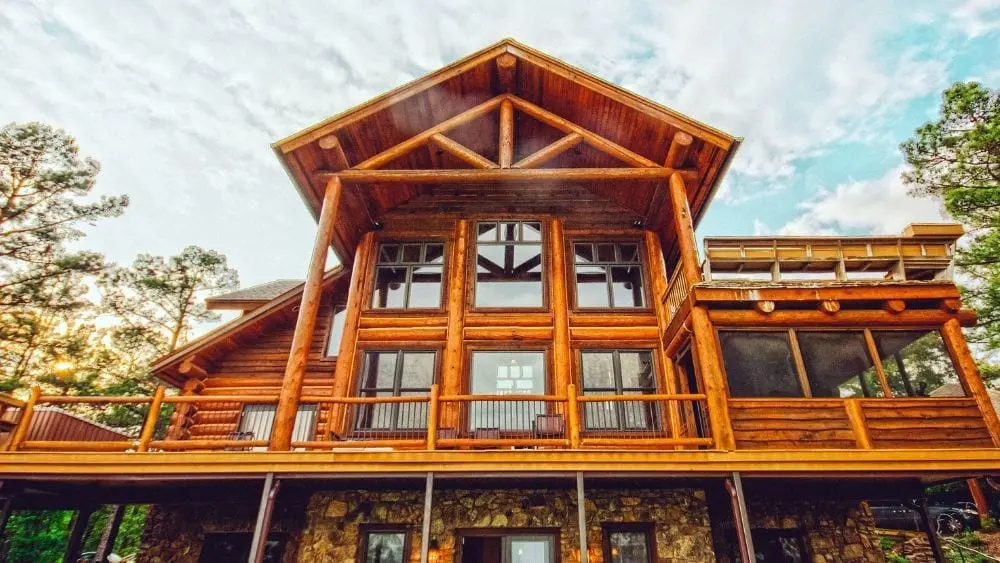
Log homes have been capturing homeowners’ imaginations in
America since the 1600s, and for good reason: Their aesthetic invites dwellers
to embrace a simple, quiet state of mind. With today’s expectation to be in
constant motion, everything the log home stands for is more important than
ever.
But before you go hacking down trees and declaring yourself
a new forest dweller, know that the pleasantries of cabin living don’t
necessarily come easy. Log homes are unique in everything from their appearance
to their construction process, and being unaware of these differences can cause
a few headaches down the line.
Thinking about building a log home? Here are seven things
you need to know before jumping in.
Log Cabin vs. Log Home
You’ve been saying log
home, but isn’t the proper term log cabin?
Yes and no! A log home is any structure built by logs, while a log cabin is typically the smaller, more secluded, less-modern version — one of those “a square is a rectangle but a rectangle isn’t a square” situations. It mostly comes down to square footage, location, amenities, and upgrades, so while we’ll be using the term “log home,” know this can mean log cabin or log … shoe house, or whatever sort of log structure you’re building. (If you build or have built a log home shaped like a shoe, please share photos!)
The Styles are Endless
Log homes are as unique as the people who build them:
Different trees, different corner construction, different processes for stacking
and anchoring the logs — each one of these factors changes a log home’s
appearance in drastic ways. Homeowners can choose between sawn logs — which are
sawed at consistent widths but still
maintain their uniqueness — or milled logs, which are sent through a mold so
both size and appearance are regulated.
Although part of the appeal of a log home is that the logs
make up the entire interior and exterior, modern takes on this classic often
involve different materials as well. A brick entryway or fireplace might suit
your aesthetic better, or you could find that the overall brightness drywall
brings to a space is more important than being a wood loyalist. Whatever you
fancy, today’s log homes have come a long way from simple structures in the
woods and can be designed to fit almost anyone’s taste.
Electricity and Wiring are … Complicated
Something you’ll see several log home owners complain about is unbearable warmth in the summer and freezing temperatures in the winter. Not only does this lead to an uncomfortable living environment, but it can also cause financial strain. How can you prevent this?
A common problem is incorrect construction, resulting in
gaps in the logs that prevent insulation. Be sure that you’re intentional about
what type of wood you’re using to construct your home — research which retain heat best in your area —
and make sure you’re working with a professional that knows what they’re doing.
This process of filling checks or gaps with an elastic sealant or chinking is
an important step that can’t be skipped. It helps ensure that your home stays a
comfortable temperature.
Aside from heating and cooling, wiring for electric access is
tricky. Drilling through a log, running wire, placing outlets and light
switches around the home — you’ll want a professional to help guide you through
the process. The sheer size of the logs makes planning absolutely essential,
and last-minute changes aren’t exactly an option. As long you think things
through, though, you’ll have a modern log home in no time.
The Views Really are that Beautiful
Log homes have become synonymous with wide open spaces and
beautiful backdrops, precisely because their rustic appearance flows better out
in the wilderness or countryside and the aesthetic appeals to people drawn to
nature. As you plan your log home, take into consideration where your home will
be placed so you can make sure the picturesque background you’ve been dreaming of
is definitely within reach. There’s nothing quite as amazing as waking up to a
breathtaking view each morning.
It’s More Maintenance than You Think
Just because log homes hearken back to a simpler time
doesn’t mean that everything about them is simple and easy. The uniqueness of
this home style stretches into its maintenance, so you need to know what you’re
getting yourself into before you commit.
For instance, no one enjoys bugs in their home, but log
homes are prime real estate for critters. Sometimes insects are already present
in the wood during construction, and sometimes they find their way into your
safe haven after construction. How do you keep them out? Wood needs to be dried
and treated properly with preventatives during the construction phase, and
after moving in, you have to be a responsible log home owner. Regularly inspect
the exterior of your home; at any sign of a possible infestation, investigate
and seek professional help. While some pests are more nuisance than problem, others
have the ability to do serious damage to your home.
Another part of regular maintenance for log homes is
refinishing and restaining the exterior. As the elements test your home, the
finish will gradually whittle away and need to be reapplied. Be prepared to
refinish your home as often as every three to four years (although some
finishes last much longer).
Whether or not you’re prepared for it, your log home will
also have a few separation issues. Over time (most predominantly in the first
three years), logs shrink as moisture continues to dry; this causes small
cracks or gaps to appear in and in between logs. Called checking, the cracks
happen to every log home, but it’s still an obstacle of which to be aware. As
noted earlier, it’s important to treat these cracks with a chinking material to
keep the logs in good shape.
Are we talking you out of building your dream home? Don’t run away yet! One huge benefit of log homes is their transparency when it comes to their needs. Worried carpenter ants have infested? Look for small holes indicating burrowing pests, perhaps with small amounts of sawdust near the holes. Noticing a line of wood rot on one side of the home, just underneath the gutter? Sounds like the gutter isn’t installed correctly and allows water to run down the side of the house. Log homes are very communicative, and as long as you’re listening, problems aren’t likely to get out of hand and become unfixable.
Rustic isn’t Your only Friend
To be honest, you probably shouldn’t be considering a log
home if the rustic aesthetic doesn’t somewhat appeal to you. But if you’re not
completely on board with antlers on every wall and constantly being bombarded
with wood, that’s just fine. We mentioned earlier that bringing other materials
like brick or drywall to the interior can help break up the space, but those
aren’t your only options. Think about painting window frames and cabinets, or
using non-wood materials for the floor. Bringing in mirrored décor and
furniture also does a lot to brighten a space.
No matter your tastes, you don’t want one pattern dominating
every single room. Don’t be afraid to break up the character of your home with
large wall hanging pieces or a splash of paint. A log home isn’t any less of a
log home just because you’ve deviated from the 100 percent rustic aesthetic.
You can Build One from a Kit
In the instant-access world we live in, someone is always
looking for an easier (and often quicker) solution. Building a log home by hand
is an incredible learning experience, but it can take years to complete.
Looking for a quicker option?
Consider a log cabin or home kit, in which all of the
necessary parts are delivered to your door for assembly. This means the
chopping, drying and shaping of the logs isn’t a process you have to worry
about! Plenty of companies offer log home kits, giving you an ideal rustic
getaway within just a few weeks.
Not Ready to Commit?
Maybe the great wide wilderness isn’t calling your name yet,
or perhaps you’re just rethinking log paneled everything. That’s OK! There are plenty of ways to bring the
rustic aesthetic into your new home. And if you’re just getting started
imagining your new home, visit NewHomeSource
for current listings all over the country.

Kian Zozobrado joined Builders Digital Experience (BDX) in 2019 as a content writer. A graduate of Southwestern University with a degree in English, Kian is passionate about the written word and making connections. Outside of work, Kian also serves as president of the Board of Directors for the Writers’ League of Texas.
 New Home Checklist: What to do as Soon as You Move In
New Home Checklist: What to do as Soon as You Move In
Thomas Peterson
You made a good point that log homes are unique and have the ability to reflect different styles in a multitude of ways. I’ve been wanting to build a cabin in the mountains to be a nice getaway every now and then. Maybe I should get in touch with come contractors and see what it takes to get done.
Afbraakwerken
While everyone wants a log home as their dream home, few of them really understand the importance of having the right one. Your blog has given lot of information about log homes and log cabins. You have explained it in a simple manner. Thanks for posting this information.